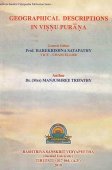Ritu, Ṛtu: 28 definitions
Introduction:
Ritu means something in Hinduism, Sanskrit, Jainism, Prakrit, the history of ancient India, Marathi, Hindi. If you want to know the exact meaning, history, etymology or English translation of this term then check out the descriptions on this page. Add your comment or reference to a book if you want to contribute to this summary article.
Ritu has 27 English definitions available.
The Sanskrit term Ṛtu can be transliterated into English as Rtu or Ritu, using the IAST transliteration scheme (?).
Alternative spellings of this word include Hritu.
Languages of India and abroad
Sanskrit dictionary
[Deutsch Wörterbuch]
Source: Cologne Digital Sanskrit Dictionaries: Böhtlingk and Roth Grosses Petersburger WörterbuchṚtu (ऋतु):—
--- OR ---
Ṛtu (ऋतु):—
2) so v. a. Monat [WEBER, Jyotiṣa 112. Nakṣ. 2, 341. 351.] Halbmonat: bahule pyṛtau [Jyotiṣa 30.] Bez. der Zahl sechs [Varāhamihira’s Bṛhajjātaka S. 77, 24. 98, 1.] [Weber’s Indische Studien 8, 167.] —
7) Nomen proprium eines Ṛṣi [Weber’s Indische Studien.3,210,b.]
--- OR ---
Ṛtu (ऋतु):—
2) als Bez. der Zahl sechs [Sūryasiddhānta 1, 31. 37. 12, 88.] —
3) die Zeit wird [Bhāvaprakāśa 2] [?auf 16] Tage vom Erscheinen der menses an gerechnet.
Source: Cologne Digital Sanskrit Dictionaries: Sanskrit-Wörterbuch in kürzerer FassungṚtu (ऋतु):—m. —
1) zutreffende Zeit , Zeitpunct , zugemessene Zeit. Instr. Sg. und Pl. zu seiner Zeit , in den rechten Zeiten , zur Opferoder Festzeit. —
2) Zeitabschnitt , insbes. Jahresabschnitt , Jahreszeit. Es werden deren [5,6] (so stets in der späteren Litetaur) , [7,12] ( = Monat oder 24 ( = Halbmonat ) angenommen. ṛtau in der entsprechenden Jahreszeit. Sg. auch in collect. Bed. —
3) Bez. der Zahl sechs. —
4) die Regeln der Weiber , insbes. die unmittelbar darauf folgenden , zur Empfängniss geeigneten Tage (nach [Bhāvaprakāśa] die 16 Tage nach dem Erscheinen der menses ). —
5) der Beischlaf zu dieser Zeit. —
6) bestimmte Folge , Ordnung , Regel. —
7) *Glanz. —
8) *schwarzes Schwefelantimon. —
9) Nomen proprium — a) eines Ṛṣi. — b) des 12ten Manu.
Sanskrit, also spelled संस्कृतम् (saṃskṛtam), is an ancient language of India commonly seen as the grandmother of the Indo-European language family (even English!). Closely allied with Prakrit and Pali, Sanskrit is more exhaustive in both grammar and terms and has the most extensive collection of literature in the world, greatly surpassing its sister-languages Greek and Latin.
See also (Relevant definitions)
Starts with (+100): Ritual language, Ritual purification, Ritualism, Ritubaddha, Ritubana, Ritubhaga, Ritubhaj, Ritubheda, Ritubhuhvaya, Ritucakra, Ritucarca, Ritucarya, Ritucharya, Ritudana, Ritudarshana, Ritudbhava, Ritudevata, Ritudhaman, Ritudharma, Ritudharmashastra.
Ends with (+58): Abhicaritu, Abhicharitu, Acalpilanteritu, Adhvaryukritu, Akhandittu, Anaritu, Anritu, Anussaritu, Caritu, Ceritu, Ciliritu, Ciritu, Cirucciritu, Dharitu, Durdharitu, Dushtarataritu, Dushtaritu, Ekartu, Eritu, Etiritu.
Full-text (+247): Himtu, Akhandittu, Ritugana, Rituparyaya, Ritukala, Ritulinga, Ritusnata, Rituyaja, Ritucarya, Ritupatra, Ritugraha, Ritusatmya, Ritumati, Ritumukha, Shadritu, Shat-ritu, Ritavya, Ritumukhin, Taptu, Varshartuvarnana.
Relevant text
Search found 54 books and stories containing Ritu, Ṛtu, Rtu; (plurals include: Ritus, Ṛtus, Rtus). You can also click to the full overview containing English textual excerpts. Below are direct links for the most relevant articles:
Rig Veda (translation and commentary) (by H. H. Wilson)
Kavyamimamsa of Rajasekhara (Study) (by Debabrata Barai)
Part 8.8 - Region of Madhyadeśa (central part) < [Chapter 5 - Analyasis and Interpretations of the Kāvyamīmāṃsā]
Part 8.14 - Characteristics of Grīṣma-kāla (summer season) < [Chapter 5 - Analyasis and Interpretations of the Kāvyamīmāṃsā]
Part 9 - Deśa-vibhāga and Kāla-vibhāga < [Chapter 3 - Contribution of Rājaśekhara to Sanskrit Poetics]
Puranic encyclopaedia (by Vettam Mani)
Significance of the Moon in Ancient Civilizations (by Radhakrishnan. P)
5. Chandramasa and Seasons < [Chapter 5 - Adoration of the Sun and Moon]
1. Assumptions of Vedakala < [Chapter 5 - Adoration of the Sun and Moon]
3. Moon in Jyotisha < [Chapter 2 - A Sceintific Outlook on Astrology]
The Skanda Purana (by G. V. Tagare)
Appendix 3 - Purāṇic measurements of time < [Appendices]
Chapter 272 - Characteristics of Different Yugas < [Section 1 - Tīrtha-māhātmya]
Chapter 194 - Description of Tīrthas < [Section 1 - Tīrtha-māhātmya]
Karmic Astrology—a Study (by Sunita Anant Chavan)
Part 2.2.2 - Units of time < [Chapter 2 - Jyotiḥśāstra and the Concept of Karman]
Part 2.2 - Jyotiḥśāstra in the Brāhmaṇa Period < [Chapter 3 - Development of Jyotiḥśāstra and Karman in the Literature]
Part 1.2 - Jyotiḥśāstra in the Saṃhitā Period < [Chapter 3 - Development of Jyotiḥśāstra and Karman in the Literature]
Related products
